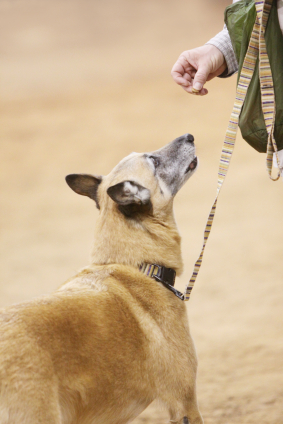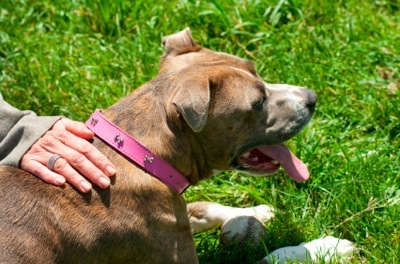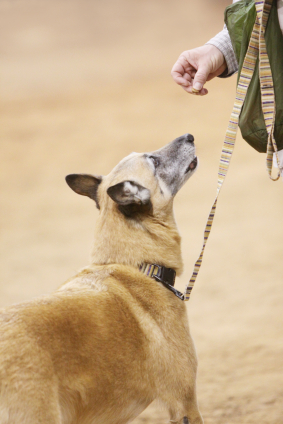Living with a deaf pet brings unique joy and challenges, though these dogs and cats typically have a harder time getting adopted.
At Pets for Patriots, our program is dedicated exclusively to connecting military personnel with pets that are most overlooked for adoption, including adults, large breed dogs and special needs dogs and cats. This includes animals that are hearing and sight impaired, and who are no less deserving of a loving home.
How pets lose their hearing
A hearing-impaired animal might not have been born deaf, but may have lost its hearing due to illness, traumatic injury, old age or even a toxic drug reaction. Much like people who are hearing impaired, these dogs and cats rely more heavily on their other senses – particularly sight and touch – to understand their surroundings and bond with their families. Increasingly, people are teaching their hearing-challenged pets sign language as another way to communicate, and non-deaf animals can be taught sign language as well if they are being placed with hearing impaired individuals. 
Some dog breeds have a higher propensity for deafness than others, including Dalmatians, Catahoula Leopard Dogs and White Bull Terriers. Interestingly, white cats have a relatively high incidence of deafness as well, regardless of breed.
Is my pet deaf or just ignoring me?
You might suspect hearing impairment if your pet is unresponsive to various stimuli that would normally elicit a reaction, such as calling its name, ringing the doorbell, clapping your hands or even turning on the vacuum cleaner. However, the only way to be certain is to have your pet BEAR tested, which stands for Brainstem Auditory Evoked Response. An experienced veterinarian, animal audiologist or board-certified veterinary neurologist will be able to administer the test. It is neither invasive nor painful for the animal, and is the only way to officially diagnose deafness in your dog or cat.
Separating fact from fiction
Most misconceptions about deaf pets arise from a lack of understanding. One common “myth” is that these pets are more difficult to train, but the reality is that they just need to be trained differently. For example, you can call a pet that isn’t hearing challenged from across the room or the yard, and know that it will respond. To get the attention of a hearing-impaired pet, you need either to be within eyesight of the animal to get its attention or close enough to give it a gentle tap. Sometimes the mere vibrations of you moving closer to your pet will get its attention.
People who work with hearing impaired dogs observe that it’s more difficult for the animal if its hearing loss is sudden, such as in the case of trauma or illness. The pet is accustomed to receiving information from the world – including from its human family – in ways that may no longer apply. Owners need to adjust as well, and be particularly reassuring to a pet who may initially feel “lost” when it loses its ability to hear.
Regardless of whether your pet’s deafness is acquired or from birth, there are many ways to train your dog to minimize the negative impacts of its hearing loss and ensure a normal lifestyle. Some similar techniques are effective with deaf cats as well.
Special health and safety needs of deaf pets
For the most part, deaf pets don’t have special health concerns and many will live a normal lifespan if given what every pet needs: love, food, shelter, exercise and good veterinary care. Yet because their hearing impairment changes the way they connect with the world around them, there are some extra safety considerations.
Keep your deaf cat away from unfamiliar animals for its own protection. A deaf cat will not be able to hear the typical warning signals from other pets, such as a hissing cat or growling dog.
Deaf pets generally require extra vigilance, since they might not perceive threats until it’s too late. Make sure your yard or garden is fenced, and keep your pet leashed whenever it’s in an unenclosed area. You can use flexi-leashes or other extended leashes that still let your pet play outdoors, but give you a measure of control. 
Many deaf animals become insecure when they realize you’re out of eyesight. As you move around your home, and in particular when you leave, be sure to make contact with your pet so that it knows where you are and what you’re doing. This can be accomplished through eye contact, hand signal or touch.
Adopting a deaf pet
When you’re ready for the special joy of adopting a deaf dog or cat, contact your local shelter or rescue to see if any animals in their charge fit the bill. Petfinder has a database of deaf animals as well, as part of an awareness campaign about hearing impaired pets. Following are organizations that focus on the adoption, education and/or training of deaf pets:
- Pets With Disabilities
- Deaf Dogs Rock
- Deaf Dog Education Action Fund (multi-state shelter/rescue listing)
- DForDog (sign language for dogs)
- Deaf Dogs Need Love Too
What training or lifestyle tips can you share for living with a deaf pet?












I’ve had a congenitally deaf cat for many years! She’s an all-white short hair with one blue eye and one green one, but she’s all the way deaf.
She. Is. A. Joy! If anything, she’s more attached/affectionate for her disability, bc she wants to know where everyone is at all times.
I literally almost never notice her disability, actually. She usually senses the change in air flow when I get home and gets up, or I’ll flicker the lights a couple times if she doesn’t get up. I’ve also easily trained her to come to me on command with a specific hand gesture, as opposed to calling for her.
I literally almost don’t notice she’s deaf; she acts so natural!
Hello everyone,My name is Mushu, a 1 1/2 year old mix black lab. I keep Simuka from over exnetirg herself with homework. She has been working toward’s a certificate in medical coding and associates degree. The only thing she doesn’t like about school is the blogging.We live on the south shore of Lake Aleknagik, Alaska. She has been here for 12 years. She is a journeyman carpenter and commercial fisherman. I love being outdoors with her.
Hi P4P,
Interesting article the gives a good idea of how it’s not difficult but is rather joyful to adopt a deaf pet.
Until I read this I wouldn’t have considered adopting a deaf pet but now that I have I think that bonding would be even stronger than average.
Good resource section.
=^-^= Hairless Cat Girl =^-^=
We had the joy of welcoming Izzy, a deaf 7 yr old JRT into our family last year. Iz was most likely born deaf, but is completely in denial of that fact. She made herself a member of our family within 15 minutes and none of us has ever had a minute of regret. She is a sound sleeper, a good eater, and a very clean dog. She watches our other rescue dig Ivy for cues for everything from treats and doorbells to the exact time our kids will get off the bus. She has even learned to ring the strand of jingle bells at our backdoor when she needs to go outside. Though she has never seen a laundry basket full of clean, folded clothes she doesn’t like, or a bathtub drain that doesn’t need watching, those quirks only make her more interesting. We have been very blessed by her sweet smile and loving heart, and could not be happier with our “hard to place” pup. Thanks to Citizens for Humane Action for saving her.